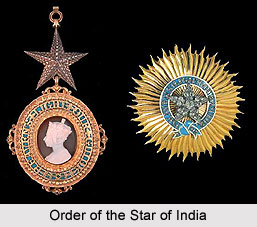 Order of the Star of India, also known as The Most Exalted Order of the Star of India is an order of chivalry established by Queen Victoria in the year 1861. The Order of the Star of India Order includes members of 3 classes, namely Knight Grand Commander (GCSI), Knight Commander (KCSI) and Companion (CSI). Since the Partition of India in the year 1947 no appointments have been made after the 1948 New Year Honours. The Maharaja of Alwar was the last surviving knight who died in 2009 and the order became inactive and dormant. The motto of the Order of the Star of India is "Heaven`s light our guide". The emblem of the order, that is the Star of India, appeared on the flag of the Viceroy of India. This particular order is the senior order of chivalry which is related with the Empire of India; where as the junior order is The Most Eminent Order of the Indian Empire. The Imperial Order of the Crown of India was for women only. Members of all classes of the Order were assigned positions in the order of precedence.
Order of the Star of India, also known as The Most Exalted Order of the Star of India is an order of chivalry established by Queen Victoria in the year 1861. The Order of the Star of India Order includes members of 3 classes, namely Knight Grand Commander (GCSI), Knight Commander (KCSI) and Companion (CSI). Since the Partition of India in the year 1947 no appointments have been made after the 1948 New Year Honours. The Maharaja of Alwar was the last surviving knight who died in 2009 and the order became inactive and dormant. The motto of the Order of the Star of India is "Heaven`s light our guide". The emblem of the order, that is the Star of India, appeared on the flag of the Viceroy of India. This particular order is the senior order of chivalry which is related with the Empire of India; where as the junior order is The Most Eminent Order of the Indian Empire. The Imperial Order of the Crown of India was for women only. Members of all classes of the Order were assigned positions in the order of precedence.
History of Order of the Star of India
Many years after the Indian revolt and the union and merger of the power of the British Empire as the governing authority in India, it was decided by the British Imperial administration that a new order of knighthood would be created in order to honour Indian Princes, small kings and local chiefs. Apart from this, it was also decided that some of the British officers and administrators who served in India would also be honoured. On June 25, 1861, the Queen expressed, through a proclamation, Her resolution to take upon Herself the Government of the Territories in India and to institute, create and constitute an Order of Knighthood to reward conspicuous merit and loyalty. The name, style, and designation of the order were thus known as The Most Exalted Order of the Star of India.
First Appointees of Order of the Star of India
The first appointees of The Most Exalted Order of the Star of India are-
* Maharaja Sir Jung Bahadur Rana
* Nawab Mir Tahniat Ali Khan Bahadur, Afzal ad-Dawlah, Asaf Jah V, the Nizam of Hyderabad
* Jayajirao Scindia, Maharaja of Gwalior
* Maharaja Duleep Singh, former Maharaja of the Sikh Empire
* Ranbir Singh, Maharaja of Jammu and Kashmir
* Tukojirao Holkar, Maharaja of Indore
* Narendra Singh, Maharaja of Patiala
* Khanderrao Gaekwad, Maharaja of Baroda
* Nawab Sikander Begum, Nawab Begum of Bhopal
* Yusef Ali Khan Bahadur, Nawab of Rampur
* Lord Gough, Commander-in-Chief of the Indian Army
* Lord Harris, Governor of Madras
* Lord Clyde, Commander-in-Chief of the Indian Army
* Sir George Russell Clerk, Kt., Governor of Bombay
* Sir John Laird Mair Lawrence, Bt., GCB, Lieutenant-Governor of the Punjab
* Sir James Outram, Bt., Member of the Viceroy`s Council
* Sir Hugh Henry Rose, Commander-in-Chief of the Indian Army
Development of Order of the Star of India
The Order of the Indian Empire was established in the year in 1877 and planned as a less elite and private version of the Order of the Star of India. Accordingly, several more appointments were made to The Most Exalted Order of the Star of India. In the 1948 New Year Honours, the last appointments to the orders were made, which was associated with the British rule in India. It was conducted a few months after the Independence of India in August 1947. The orders have never been formally abolished but there are surviving members of The Most Exalted Order of the Star of India.
The last surviving Knight Grand Commander, Maharaja Sri Sir Chithira Thirunal Balarama Varma GCSI, Maharaja of Travancore, died on July 19, 1991 in Trivandrum. The last living Knight Commander, Maharaja Sri Sir Tej Singh Prabhakar Bahadur KCSI, Maharaja of Alwar, died on February 15, 2009 in New Delhi.



















